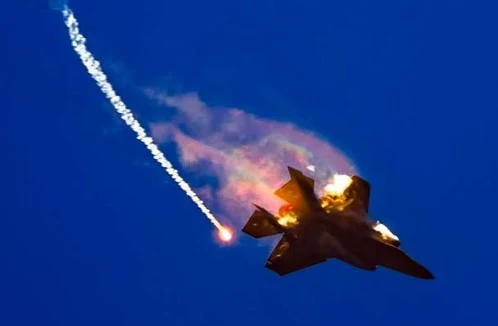 |
| Iran Simulates Shooting Down of F-35 Stealth Fighter Jet in War Exercises |
Tahran - The Iranian military has targeted drones produced similar to the US-made F-35 stealth fighter jets as targets to be shot down. That was done in their latest war games in the Persian Gulf. They announced that the maneuvers began with the engagement of locally produced cruise missiles, drones and other weapons. It was Iran's second war games in recent weeks.
The latest drills are part of Iran's efforts to demonstrate locally produced weapons and overall military prowess against adversaries. Once again, Iran reiterated that its weapons are made domestically, underscoring its insistence that it does not depend on other countries for military support.
Iranian media said the Iranian Navy carried out a series of attacks using missiles and ships at sea, including defensive mines placed in firing ranges simultaneously and the use of sea cruise missiles from two different geographical areas to hit specific targets. The report also stated that Iranian drones were used to hit specific targets without providing more information.
An image that appeared on Twitter on January 18 has generated widespread interest among social media users and military observers. In the photo, an unmanned aerial vehicle (UAV) is seen flying over the area where the drills are taking place.
Interestingly, the drone looks like an F-35 stealth fighter jet and is a target for shooting. According to several Twitter accounts that track Iranian military activity, the purported target drones have also been used in previous military exercises. A Twitter account with the name "Iran Defense" said that target drones had previously been used for target shooting practice in the Islamic Revolutionary Guard Corps' (IRGC) Basij drills.
According to some claims, sources in Iran confirmed that the drone was made with a layout design that resembles the F-35 fighter and was used to strengthen Iran's fight against Israeli and United States warplanes. This is important as tensions have been steadily increasing in the region recently.
Iran tracking or simulating an attack on an F-35-like aircraft is important because Israel has threatened to strike using F-35I Adir aircraft against Iranian nuclear installations. Most likely the Iranian military is training to hit targets with existing air defense systems with the help of such drones.
However, Iran's ability to intercept F-35 stealth fighter jets has been an ambition for a long time. Israeli F-35 warplanes reportedly repeatedly penetrated Iranian airspace, according to a report on the Saudi news outlet Elaph in August 2022 meaning the stealth aircraft was able to evade Iranian air defenses.
By contrast, Russian state media TASS reported last year that US F-35 warplanes were spotted and tracked near Iran's borders during the escalation of tensions in early 2020. Iran purchased a Russian-made radar, Rezonans-NE, to identify and track stealth aircraft. and hypersonic targets.
Iran Ready to Fight Israel's F-35
Disappointed by US-Iran nuclear talks, Israel has issued numerous warnings that it will bomb Iran's nuclear facilities if negotiations fail.
In September, Former Israeli Prime Minister Yair Lapid visited the Nevatim airbase, home to a squadron of Israeli Air Force (IAF) F-35 fighter jets.
Standing in front of the F-35, Lapid said, “If Iran continues to test us, it will discover Israel's long arms and capabilities. We will continue to act on all fronts against terrorism and against those who seek to harm us." In his video address, he stated that it was too early to say whether the nuclear agreement was blocked. "It is too early to know whether we have succeeded in terminating the nuclear agreement, but Israel is ready for every threat and every scenario,” Lapid said.
While the nuclear talks have been cancelled, the "long arm" comment refers to the F-35's ability to travel long distances to bomb Iran's nuclear facilities without stopping to refuel.
Israel operates the F-35-I—sometimes referred to as the “Adir”, a heavily modified Lockheed Martin F-35 stealth fighter. As part of the upgrade, new one-tonne bombs can be placed in the F-35's internal weapons bay without affecting aircraft stealth radar signals and armaments that are already available.
For its part, Iran is also preparing to combat the looming Israeli threat and establish an effective deterrence by acquiring Russian Su-35 fighter jets. Earlier this week, Iran confirmed it had ordered 12 Russian planes and would receive them within the next three months.
Additionally, Iran is investing millions of dollars in the deployment in Syria of its Bavar-373 air defense system, which it claims is on par with Russia's S-400, to protect its assets from Israeli airstrikes. Iran could use the air defense system to protect its important and military installations from Israeli F-35s.
According to local media reports, the F-35 stealth jet can be tracked and attacked using the Sayyad-4B missile with the Bavar-373 AD platform. The estimated range of this missile is between 250 and 300 kilometers. As tensions continue to escalate between the two sides, especially given Iran's projected military prowess, both sides can only be expected to prepare for a potential battle. The F-35 target drone can be seen as a step in that direction.
